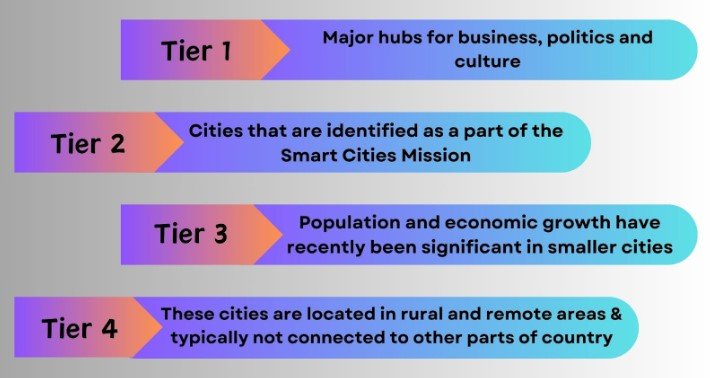The growth of Tier-2 cities in India is intricately linked to the rise of a new middle class and the expansion of a culture of consumption. These smaller cities, which are not the primary metros but still important urban centers, have seen significant development over the past few decades. This shift is largely driven by economic reforms, increased investment, urbanization, and the spread of technology.
1. Economic Growth and Emerging Middle Class in Tier-2 Cities
- Economic Opportunities: Over the last few decades, economic liberalization in India, along with growth in sectors such as IT, manufacturing, and retail, has spurred the economic development of Tier-2 cities like Indore, Jaipur, Surat, Lucknow, and Coimbatore. These cities are experiencing rising income levels and job opportunities, leading to the emergence of a new middle class.
- Affordable Real Estate: Tier-2 cities offer lower real estate prices and a lower cost of living compared to Tier-1 cities like Mumbai or Delhi. As a result, they have become attractive hubs for businesses, including startups and IT companies, creating job growth and upward economic mobility for a growing population.
- Better Quality of Life: Many Tier-2 cities offer a better work-life balance, improved infrastructure, and affordable education and healthcare, making them desirable places for the new middle class to settle and invest in.
2. Rise of the New Middle Class
- Income Growth: The expanding middle class in Tier-2 cities is characterized by rising disposable incomes and aspirations for upward social mobility. Unlike the traditional middle class in metros, this new middle class often consists of first-generation earners or those transitioning from agrarian or small-business backgrounds into more formal employment sectors.
- Aspiration for Lifestyle Upgrades: This middle class aspires to a lifestyle associated with wealth and modernity. With rising incomes, there is a strong desire for consumption of goods and services that signal status, convenience, and comfort. This includes spending on branded goods, consumer electronics, vehicles, and housing.
3. The Culture of Consumption in Tier-2 Cities
- Expansion of Retail and E-Commerce: The retail landscape in Tier-2 cities has been rapidly transforming with the entry of shopping malls, supermarkets, and e-commerce platforms. Global and national retail chains have expanded into these cities, catering to the growing middle class’s appetite for consumer goods. Companies like Amazon, Flipkart, and Reliance Retail have recognized the purchasing power in these cities and are tailoring their services to reach these markets.
- Changing Consumer Behavior: With increasing exposure to global lifestyles through media, social networks, and advertising, the middle class in Tier-2 cities is shifting toward brand consciousness and discretionary spending. Consumption patterns now reflect a desire for luxury items, entertainment, fashion, and technology products, similar to what is seen in larger metros.
- Automobiles and Real Estate: The automobile market has seen significant growth in Tier-2 cities, with rising demand for personal vehicles as symbols of social mobility. Similarly, the real estate sector has expanded, with a focus on housing projects that cater to middle-class aspirations for larger homes, gated communities, and modern amenities.
4. Factors Driving the Consumption Culture
- Increased Access to Credit: Banks and financial institutions have made credit and loan facilities more accessible to the emerging middle class in Tier-2 cities. Consumer loans, EMIs, and personal finance options have fueled spending on homes, cars, consumer electronics, and luxury items.
- Digitization and Connectivity: The penetration of smartphones and internet connectivity has given residents of Tier-2 cities access to e-commerce platforms, online education, and entertainment. With the rise of digital payments and online shopping, there has been a surge in consumption driven by the ease of purchasing goods online.
- Media and Social Influence: Social media platforms and television have played a significant role in shaping the consumption behavior of this middle class. Exposure to global trends and influencers has created aspirations to emulate urban lifestyles, which further fuels the demand for branded products, fashion, and luxury goods.
5. Social and Cultural Implications of Consumption
- Shift in Social Norms: The culture of consumption has also led to a change in traditional social norms. There is a growing emphasis on individualism and status symbols, where material possessions are seen as markers of success. This shift has impacted everything from fashion choices to social gatherings, leading to a more consumer-driven identity in these cities.
- Generational Impact: Younger generations in Tier-2 cities are embracing consumerism at a faster pace compared to older generations, often influenced by global trends and technology. Millennials and Gen Z in these cities are more likely to seek experiences such as travel, dining out, and entertainment, in addition to material goods.
Challenges of Rising Consumption in Tier-2 Cities
- Environmental Impact: Increased consumption in Tier-2 cities can lead to higher resource consumption, waste production, and pollution. As more people buy vehicles, appliances, and electronics, the demand for energy and disposal of waste poses environmental challenges.
- Social Inequality: While consumption levels are rising for the middle class, there is still significant income disparity in these cities. The focus on consumerism may highlight inequalities, as lower-income groups struggle to keep up with the aspirational lifestyle of the middle class.
- Pressure on Infrastructure: The rapid urbanization and growing consumption in Tier-2 cities put pressure on infrastructure, including roads, water supply, waste management, and public services, which may struggle to keep up with the pace of growth.
Conclusion
The rise of Tier-2 cities in India has led to the growth of a new middle class with an expanding culture of consumption. This new middle class, driven by higher incomes, aspirations for upward mobility, and access to global trends, has contributed to the transformation of these cities into hubs of economic and social activity. However, the rise in consumption also brings challenges related to environmental sustainability, social inequalities, and infrastructure development. As Tier-2 cities continue to grow, their middle class will play a crucial role in shaping the economic and cultural landscape of modern India.


